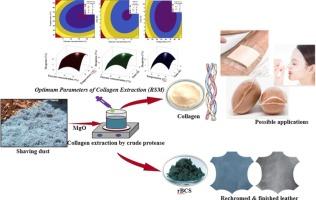Optimizing extraction of collagen from hazardous leather shaving dusts by crude protease enzyme: Chrome recovery and reuse for leather rechroming
Q1 Environmental Science
引用次数: 0
Abstract
This study explores an eco-friendly method to achieve 99.98 % dechroming (reducing Cr from 7700 to 4.71 ppm) of Chrome-tanned leather shaving dust (CSD), through enzymatic hydrolysis using crude protease. The enzyme exhibited strong activity (>40 U mL−1) across a temperature range of 50 °C to 65 °C and a pH range of 5 to 11. The pH of the mixture containing CSD, water, MgO, and enzyme was maintained at 8.9 during hydrolysis. The temperature, hydrolysis time, and enzyme concentration were optimized using response surface methodology (RSM). Under optimal conditions of 17.57 % enzyme concentration, 62.01 °C, and a hydrolysis time of 7 h, the predicted collagen yield was 31.66 %. Laboratory experiments conducted with these predicted parameters resulted in a collagen recovery of 30.9 %, achieving an accuracy of 97.6 % compared to the predictions. In contrast, hydrolysis with MgO alone achieved only 87.01 % dechroming with about 2 % collagen yield, highlighting the enzyme's superior effectiveness. The enzymatic cleavage of peptide bonds in the leather matrix enhanced collagen solubilization. Characterization techniques, including FT-IR, NMR, XRD, DSC, and TGA, confirmed successful extraction and purity, with the collagen being rich in glycine and proline. Cytotoxicity results demonstrated its non-toxic nature, indicating potential applications in biomedical fields, tissue engineering, food, pharmaceuticals, and cosmetics. The recovered chromium sulfate was reused for rechroming goat wet blue leather, with chrome content in crust leather treated with recovered basic chromium sulfate (rBCS) and fresh basic chromium sulfate (BCS) being 3.23 % and 3.35 %, respectively, both meeting industry standards for goat crust leather.
Synopsis
An eco-friendly method for dechroming chrome-tanned leather shaving dust (CSD) and extracting collagen was established. The process achieved 99.98 % dechroming and 30.9 % collagen yield using crude protease enzyme. Characterization confirmed the collagen's purity, and recovered chromium sulfate was reused for rechroming goat leather, meeting industry standards.

利用粗蛋白酶从有害皮革刮削粉尘中优化提取胶原蛋白:铬回收并重新用于皮革再染色
本研究探索了一种生态友好型方法,通过使用粗蛋白酶进行酶水解,使铬鞣皮革刨屑(CSD)的脱铬率达到 99.98%(将铬从 7700 ppm 降至 4.71 ppm)。该酶在 50 °C 至 65 °C 的温度范围和 5 至 11 的 pH 值范围内表现出很强的活性(40 U mL-1)。在水解过程中,含有 CSD、水、氧化镁和酶的混合物的 pH 值保持在 8.9。采用响应面方法(RSM)对温度、水解时间和酶浓度进行了优化。在酶浓度为 17.57 %、温度为 62.01 °C、水解时间为 7 小时的最佳条件下,预测的胶原蛋白产量为 31.66 %。根据这些预测参数进行的实验室实验得出的胶原蛋白回收率为 30.9%,与预测值相比,准确率达到 97.6%。相比之下,仅使用氧化镁进行水解仅实现了 87.01% 的脱色,胶原蛋白产量约为 2%,这凸显了酶的卓越功效。酶裂解皮革基质中的肽键提高了胶原蛋白的溶解度。傅立叶变换红外光谱(FT-IR)、核磁共振(NMR)、X 射线衍射(XRD)、数显显微镜(DSC)和热重分析(TGA)等表征技术证实了提取的成功和纯度,胶原蛋白富含甘氨酸和脯氨酸。细胞毒性结果表明胶原蛋白无毒,有望应用于生物医学领域、组织工程、食品、药品和化妆品。回收的硫酸铬被重新用于山羊蓝湿皮的再铬化,用回收的碱式硫酸铬(rBCS)和新鲜的碱式硫酸铬(BCS)处理的结皮中铬含量分别为 3.23 % 和 3.35 %,均达到了山羊结皮的行业标准。使用粗蛋白酶,该工艺的脱色率达到 99.98%,胶原蛋白产量达到 30.9%。表征证实了胶原蛋白的纯度,回收的硫酸铬被重新用于山羊皮的再铬化,符合行业标准。
本文章由计算机程序翻译,如有差异,请以英文原文为准。
求助全文
约1分钟内获得全文
求助全文
来源期刊

Bioresource Technology Reports
Environmental Science-Environmental Engineering
CiteScore
7.20
自引率
0.00%
发文量
390
审稿时长
28 days
 求助内容:
求助内容: 应助结果提醒方式:
应助结果提醒方式:


